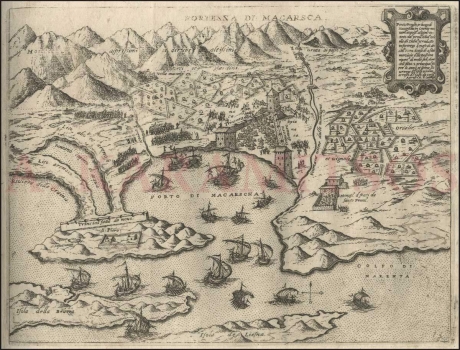CAMOCIO, GIOVANNI FRANCESCO: MAKARSKA
Inventory number 510
Original title: Fortezza di Macarsca
Publishing year: 1571
Place of publishing and publisher: Venezia
Format: 17,9 x 23,2 cm
Technique: Copper engraving
This is a detailed panoramic view of Makarska with an almost cartographic plan of the port and panoramic view of the hinterland all the way to the Biokovo Mountain (Monti aprissimi et dirupialtissimi). Camocio emphasized tiny details in defence structures, including a ditch with water in the direction of the peninsula of St. Peter (Pantano coperto di acqua). The note in the northwest pebbled and more than a kilometer-long port is extremely important (Riuiera della Craina). Namely, it is the remnant of an older name for Makarska, which can be found on earlier maps. There is also an old toponym in the foothills of Biokovo (Villa macari). Compared to the rest of the map, the overlaid ground plan of the town is triangular, open to the sea and protected by walls on both sides. Massive square-shaped towers are located in corners. Fields, gardens and orchards bordered by the walls are in the surroundings, mills are on the river, and the Franciscan monastery is in the foreground in the southwest (Monas. d frati de santo Franc.). Military formation in the moments of battle, before the destruction of the Franciscan monastery, is displayed around the city. The harbour is filled with a large number of Venetian war galleys and smaller sailing ships. Both data indicate the importance of the port in the Venetian-Ottoman conflicts, after which Makarska was not restored under the Venetian rule until 1684. A rich Renaissance cartouche with a description of the city and its surroundings is in the upper right corner. The author G. F. Camocio is signed at the end of the text. He usually signed maps he personally supplemented, which was also probably the case with this one. However, due to the extraordinary detail and greater precision of the data, the authorship of this map or the co-operation in its creation can partly be attributed to Natale Bonifacio, the Šibenik copper engraver who participated in producing the atlas Isole famose... The plate with the label 13 is in the lower right corner.
CAMOCIO, GIOVANNI FRANCESCO
CAMOCIO, GIOVANNI FRANCESCO (Camocius, Camotio, Cametti, Gioan, Joan Francisco) a Venetian cartographer, publisher and merchant whose most productive period was between 1558 and 1575. He obtained his bookseller's and publisher's licence in Venice in 1552, marked Al segno della Pyramide. His copper-plate engraving workshop produced maps and vedute that as a publisher he was signing with apresso or apud G. F. Camocio cum privilegio. The most fertile period of his artistic production, between the 1550s and the 1570s, was also the peak of the isolarii (depictions of islands) period, especially in Italy. These are detailed, practical, perspective depictions of certain cities and ports, created predominantly in a large-scale copper-plate engraving technique. Unlike earlier portulan charts, these depictions of the maritime area and the inland of the islands were largely based on field work. Along with G. Rosaccio, G. Franco and S. Pinargenti, Camocio was the most significant representative of the tradition. His interest lay on the eastern Adriatic coast where he had his informants and topographers, so he created several maps of the Croatian lands. His most famous works are Lombardija Atlantic from 1560, which he created with Forlani, Dalmatia i Friuli from 1563, Isole Famose from 1563 and 1564, Grčka, Italija i Napulj from 1566, Venecija from 1571 and Europa, published in 1579. His copper plates were passed on to Donato Bertelli. Copper plates were, at the time, passed on, inherited, exchanged and traded, and the information they carried was also often exchanged among cartographers and publishers. His most famous maps of our (Croatian) territories are Novo dissegno della Dalmatia et Crovatia from 1566, Istra from 1569, and he also authored the isolario or atlas Isole famose, porti, fortezze e terre maritimme… from 1571 and 1574, comprising a large number of maps of the Croatian territories, although he did not author all of the maps contained within it. Almost twenty of his maps are depictions of the Croatian Littoral or port vedute, but he only signed some of them, which are most likely the ones he personally refined or updated. His maps of Dalmatia and Istria show that he had access to higher quality topographic templates or data only for some regions, such as Coppo’s map of Istria from 1525. He also published the works by local cartographers, Natalo Bonifaci and Martino Rota, from where he clearly sourced the cartographic information for his own works. He was obviously very skilled in selecting the information he would use, as he tried to correct some frequently repeated errors he had come accross.


